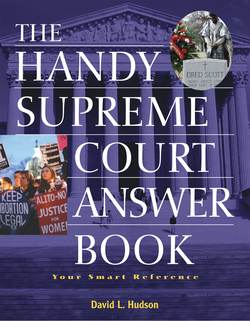Читать книгу The Handy Supreme Court Answer Book - David L Hudson - Страница 186
На сайте Литреса книга снята с продажи.
In what case did the Supreme Court define ex post facto laws?
ОглавлениеThe U.S. Supreme Court first defined ex post facto laws in Calder v. Bull (1798), a case examining whether the Connecticut legislature violated the rights of heirs (Calder and his wife) when it passed a law ordering a new hearing in a probate court. After the new hearing, the probate court ruled in favor of other heirs (Bull and his wife). The Calders argued that the Connecticut legislature’s act of ordering a new hearing in probate court constituted an ex post facto law. An ex post facto law is one that makes conduct a crime even though the conduct was not a crime when it originally occurred. In other words, an ex post facto law criminalizes conduct retroactively.
The U.S. Supreme Court unanimously ruled 4–0 that the Connecticut law was not an ex post facto law because it affected only civil law, not criminal law. Ex post facto laws, according to the justices, referred to laws that retroactively increased punishment for crimes or made certain innocent conduct a crime.
CourtSpeak: Hylton v. United States Tax Case (1796)
Justice Samuel Chase (unanimous ruling): “I think, an annual tax on carriages for the conveyance of persons, may be considered as within the power granted to Congress to lay duties…. It seems to me, that a tax on expence is an indirect tax; and I think, an annual tax on a carriage for the conveyance of persons, is of that kind; because a carriage is a consumeable commodity; and such annual tax on it, is on the expence of the owner.”
Justice William Paterson: “A tax on carriages, if apportioned, would be oppressive and pernicious. How would it work? In some states there are many carriages, and in others but few. Shall the whole sum fall on one or two individuals in a state, who may happen to own and possess carriages? The thing would be absurd, and inequitable.”
Justice James Iredell: “I am clearly of opinion, this is not a direct tax in the sense of the Constitution, and, therefore, that the judgment ought to be affirmed.”
The four justices hearing the case—Samuel Chase, William Paterson, James Iredell, and William Cushing—all wrote separate opinions, though Cushing’s was very short. This conformed with the Court’s existing practice of issuing seriatim opinions, or a series of opinions—each justice issuing his own separate opinion. Chief Justice Oliver Ellsworth and James Wilson did not participate. In the late 1790s, Wilson was beset with financial problems, including being jailed twice for his debts.
